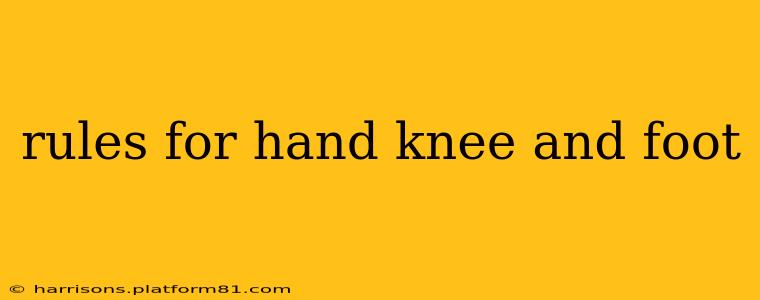Rules for Hand, Knee, and Foot Placement in Various Activities
Understanding proper hand, knee, and foot placement is crucial for safety and effectiveness in many activities, from sports and exercise to everyday tasks. The "rules" vary significantly depending on the context. This guide will explore some key areas where placement is paramount.
What are the rules for hand placement in yoga?
In yoga, hand placement is critical for proper alignment, stability, and injury prevention. The specific rules depend on the pose. Generally, you should:
- Ensure a stable base: Hands should be firmly planted, with fingers spread wide and evenly weighted.
- Maintain proper alignment: Hands should be positioned to support the body's weight and maintain correct posture. This often involves aligning wrists, elbows, and shoulders.
- Engage the muscles: Actively engage your hand and arm muscles to support your body and prevent collapse.
- Use props when needed: Blocks or straps can assist in achieving proper hand placement, especially for beginners.
What are the rules for hand placement during push-ups?
Proper hand placement in push-ups is essential for effective muscle engagement and injury prevention. Key points include:
- Shoulder-width apart: Hands should be slightly wider than shoulder-width apart, with fingers pointing forward.
- Firm grip: Press your palms firmly into the ground.
- Straight wrists: Avoid bending your wrists, maintaining a straight line from your hands to your shoulders.
- Engage your core: Tighten your abdominal muscles to stabilize your body.
What are the rules for knee placement during squats?
Knee placement during squats is often a point of confusion, with varying advice depending on individual anatomy and goals. However, general guidelines include:
- Tracking over toes (generally): Your knees should generally track in line with your toes or slightly behind them. Excessive inward or outward tracking can increase the risk of injury.
- Avoid hyperextension: Don't let your knees go past your toes, especially when using heavy weight.
- Maintain a stable stance: Your feet should be shoulder-width apart, with your weight evenly distributed.
- Consider your body type: Some individuals may naturally have a wider stance or a slightly different knee position than others; listen to your body.
What are the rules for foot placement in running?
Proper foot placement in running contributes significantly to running efficiency, injury prevention, and performance. Considerations include:
- Midfoot strike: Aim for a midfoot strike rather than a heel strike to reduce impact forces.
- Foot cadence: Increase your step frequency to reduce stress on your joints.
- Foot pronation: Assess your pronation (how your foot rolls inward) to choose appropriate footwear.
- Stance width: Keep your feet roughly hip-width apart for stability.
What are the rules for foot placement in martial arts?
Foot placement is fundamental in martial arts for balance, stability, and effective movement. Rules vary between disciplines but generally include:
- Stable base: Maintain a wide, balanced stance appropriate for the specific technique.
- Weight distribution: Distribute your weight evenly between your feet.
- Strategic positioning: Place your feet strategically to maintain balance and prepare for movement.
- Footwork drills: Regular footwork drills are crucial for developing proper foot placement techniques.
These guidelines represent a starting point. Always consult with qualified professionals, such as yoga instructors, personal trainers, or physical therapists, for personalized advice tailored to your individual needs and abilities. Remember, proper form is always paramount to safety and success in any activity involving hand, knee, and foot placement.
